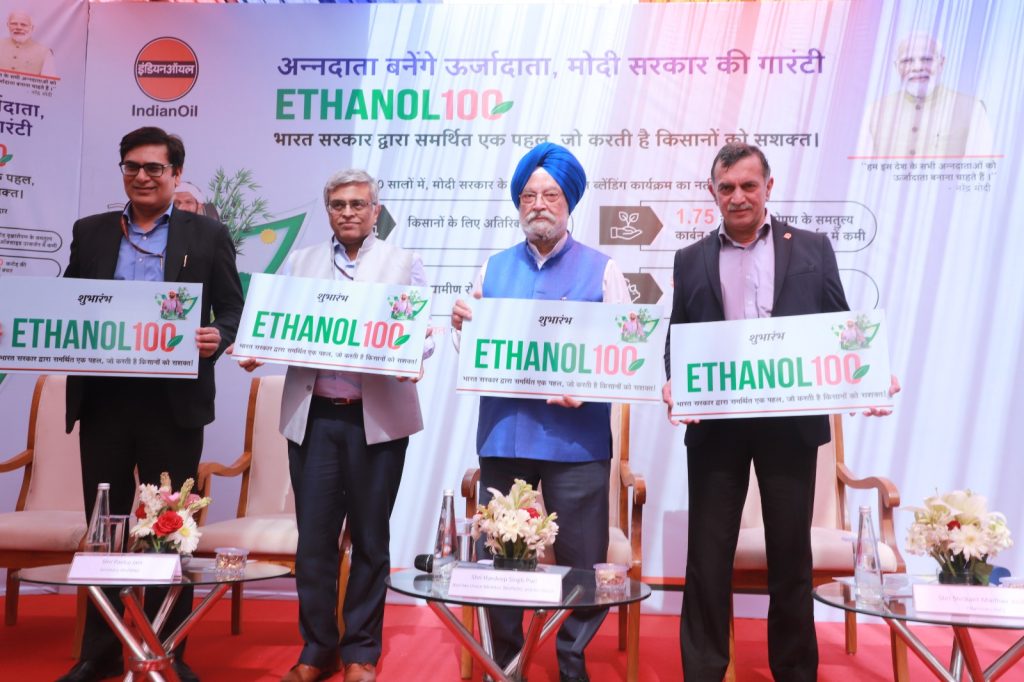Context:
The Union Minister for Petroleum & Natural Gas recently inaugurated ‘ETHANOL 100’, an innovative automotive fuel, at an IndianOil Retail Outlet.
About Ethanol 100
- Ethanol 100, also known as E100, is a type of fuel that is made up of 93-93.5% ethanol, 5% gasoline and 1.5% co-solvent (which acts as a binder).
- It is a renewable fuel that is derived from plant material, such as corn or sugarcane.
- Ethanol 100 is being promoted as a cleaner and more sustainable alternative to gasoline.
Benefits of Ethanol 100
- Reduced greenhouse gas emissions: Ethanol 100 burns cleaner than gasoline, which can help to reduce greenhouse gas emissions and combat climate change.
- High octane rating: Ethanol 100 has a high-octane rating (between 100-105), which means that it can improve engine performance and fuel efficiency while also minimizing environmental impact.
- With the launch of ETHANOL 100 at 183 outlets of IndianOil, India will achieve the target of 20% ethanol blending by 2025-26.
- Domestically produced: Ethanol 100 can be produced from domestic crops, which can help to reduce reliance on foreign oil.
Drawbacks to Ethanol 100
- Not all vehicles can use it: E100 is not compatible with all vehicles. Only flex-fuel vehicles, which are specially designed to run on gasoline, ethanol, or any blend of the two, can use E100.
- Lower energy density: Ethanol 100 has a lower energy density than gasoline, which means that vehicles will get fewer miles per gallon on E100.
- Can attract water: Ethanol 100 can absorb water from the air, which can lead to corrosion in some engines.
Flex-fuel vehicles (FFVs)
FFVs also sometimes called dual-fuel vehicles, are those that can run on more than one type of fuel. The most common combination is gasoline and ethanol blends, though methanol has also been used in some FFVs in limited applications.
Key feature of flex-fuel vehicles
- Fuel versatility: FFVs have internal combustion engines designed to operate on gasoline or gasoline-ethanol blends, typically containing up to 85% ethanol (E85) and E100.
- Automatic adjustment: These vehicles have special sensors and controls that can automatically detect the type of fuel being used and adjust the engine settings accordingly to optimize performance.
Ethanol Blending Program (EBP)
- It was launched in India in January 2003 with a 5% ethanol blend (E5) in select states to reduce reliance on imported oil.
- The Government achieved the target of 10% average blending of ethanol in Petrol in the country in June 2022.
- The Government has set a target of 20% blending of ethanol in petrol under the EBP programme by Ethanol Supply Year (ESY) 2025-26.
- Implementation: Public Sector Oil Marketing Companies (OMCs) like Indian Oil Corporation and Bharat Petroleum are responsible for procuring ethanol and blending it with petrol.
- Aims and Objective
- Reduce reliance on imported oil: By using domestically produced ethanol, India lessens its dependence on foreign oil sources for transportation fuels.
- Promote renewable fuels: Ethanol is a biofuel derived from plant material like sugarcane, making it a renewable resource.
- Boost the agriculture sector: Increased demand for ethanol production can benefit farmers cultivating sugarcane and other feedstocks.
- Improve air quality: Ethanol burns cleaner than gasoline, potentially reducing harmful emissions and improving air quality.

